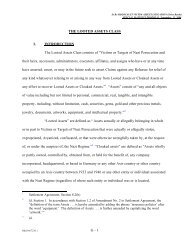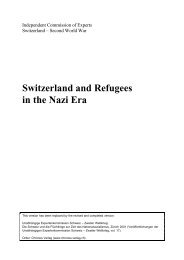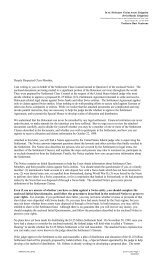Switzerland and Gold Transactions in the Second World War
Switzerland and Gold Transactions in the Second World War
Switzerland and Gold Transactions in the Second World War
You also want an ePaper? Increase the reach of your titles
YUMPU automatically turns print PDFs into web optimized ePapers that Google loves.
Interim Report on <strong>Gold</strong> 44 Chapter 1<br />
of research, such transfers <strong>in</strong> which <strong>the</strong> Reichsbank shipped gold from Berl<strong>in</strong> to <strong>Switzerl<strong>and</strong></strong> –<br />
most probably act<strong>in</strong>g upon orders received from <strong>the</strong> Soviet national bank – represented roughly<br />
34,149 kg f<strong>in</strong>e gold or <strong>the</strong> equivalent of $ 38.4 million (SFr. 166.3 million). The comments to<br />
Table II, to positions V/1 <strong>and</strong> V/3, <strong>and</strong> <strong>the</strong> remarks made at <strong>the</strong> end of Chapter 2.3.1 give a more<br />
detailed explanation about <strong>the</strong> sources <strong>and</strong> <strong>the</strong> background of <strong>the</strong>se gold transactions of Soviet<br />
orig<strong>in</strong>. It is possible that <strong>the</strong> Reichsbank purchased at least a part of this gold for itself prior to<br />
transferr<strong>in</strong>g it to <strong>Switzerl<strong>and</strong></strong>.<br />
V. Reserves at <strong>the</strong> End of <strong>the</strong> <strong>War</strong>. The gold rema<strong>in</strong><strong>in</strong>g <strong>in</strong> <strong>the</strong> possession of <strong>the</strong> Reichsbank at<br />
<strong>the</strong> time of Germany’s capitulation can be considered as <strong>the</strong> f<strong>in</strong>al balance for account<strong>in</strong>g<br />
purposes. Toward <strong>the</strong> end of <strong>the</strong> war, <strong>the</strong> Reichsbank began hid<strong>in</strong>g its gold <strong>in</strong> Germany <strong>and</strong><br />
Austria to protect it from Allied air raids. Most of this gold was secured by <strong>the</strong> Allies.<br />
V/1. <strong>Gold</strong> Recovered <strong>in</strong> Germany. In <strong>the</strong> spr<strong>in</strong>g of 1945, <strong>the</strong> Reichsbank transferred almost all of its<br />
hold<strong>in</strong>gs from Berl<strong>in</strong> to Merkers/Thur<strong>in</strong>gia. They were seized <strong>in</strong> a m<strong>in</strong>e on 15 April 1945 by US<br />
troops. Smaller amounts were found <strong>in</strong> branch offices of <strong>the</strong> Reichsbank <strong>in</strong> Germany <strong>and</strong> at<br />
German embassies abroad. The Western Allies recovered $ 265.6 million of gold <strong>in</strong> Germany <strong>and</strong><br />
centralized it <strong>in</strong> Frankfurt am Ma<strong>in</strong>. Here it was sorted <strong>and</strong> counted by <strong>the</strong> Foreign Exchange<br />
Depository, a division of <strong>the</strong> US Military Adm<strong>in</strong>istration <strong>and</strong>, after <strong>the</strong> found<strong>in</strong>g of <strong>the</strong> Tripartite<br />
Commission for <strong>the</strong> Restitution of Monetary <strong>Gold</strong>, was adm<strong>in</strong>istered on its behalf. 102 <strong>Gold</strong> of <strong>the</strong><br />
Federal Foreign Office com<strong>in</strong>g from Italy is not listed here. 103<br />
V/2. <strong>Gold</strong> Recovered <strong>in</strong> Austria. American military forces secured gold valued at $33.3 million <strong>in</strong><br />
Spital am Pyhrn which had been evacuated from <strong>the</strong> Hungarian National Bank. 104<br />
VI. <strong>Gold</strong> Shipped Abroad. Germany’s desire for gold stemmed from its need for foreign<br />
exchange, both to buy goods – especially war materials – <strong>and</strong> to make payments abroad. These<br />
payments were for items such as diplomatic representation, postal charges, <strong>and</strong> travel<br />
expenses, as well as costs for propag<strong>and</strong>a <strong>and</strong> espionage.<br />
VI/1. Swiss Banks. The most important recipient of German gold was <strong>Switzerl<strong>and</strong></strong>, which was able to<br />
provide <strong>the</strong> Germans not only with goods such as mach<strong>in</strong>ery <strong>and</strong> armaments, but also with Swiss<br />
francs. The Swiss banks also served as conduits for transferr<strong>in</strong>g German gold to third parties,<br />
especially Spa<strong>in</strong>, Portugal, <strong>and</strong> Sweden. The Swiss commercial banks were used by Germany as<br />
late as <strong>the</strong> spr<strong>in</strong>g of 1941 to make substantial dollar payments to <strong>the</strong> USSR <strong>and</strong> to <strong>the</strong> United<br />
States, as well as smaller payments to Japan <strong>and</strong> Ch<strong>in</strong>a. 105 Swiss banks received $444.1 million <strong>in</strong><br />
gold. 106 <strong>Gold</strong> shipments to <strong>the</strong> Swiss National Bank were relatively small at <strong>the</strong> beg<strong>in</strong>n<strong>in</strong>g of 1940,<br />
<strong>and</strong> reached a peak <strong>in</strong> 1943. After <strong>the</strong> beg<strong>in</strong>n<strong>in</strong>g of 1944, deliveries to Bern decl<strong>in</strong>ed rapidly, <strong>and</strong><br />
by 1945 no gold was shipped directly from Berl<strong>in</strong> to <strong>the</strong> Swiss National Bank (<strong>the</strong>re was one<br />
102 US National Archives, RG 260, F<strong>in</strong>ance, Box 469, Register of Valuables <strong>in</strong> <strong>the</strong> Custody of <strong>the</strong> Foreign Exchange<br />
Depository; Fletcher Memor<strong>and</strong>um. The difference <strong>in</strong> <strong>the</strong> sum totals <strong>in</strong> <strong>the</strong> Commission’s work<strong>in</strong>g paper of 1 December<br />
1997 results from <strong>the</strong> fact that hold<strong>in</strong>gs transported from Italy to Germany were no longer listed separately but ra<strong>the</strong>r as<br />
a part of this position. Documents consulted <strong>in</strong> <strong>the</strong> meantime have made it possible to determ<strong>in</strong>e more exactly <strong>the</strong> way<br />
<strong>in</strong> which hold<strong>in</strong>gs were divided between <strong>the</strong> Reichsbank <strong>and</strong> <strong>the</strong> Federal Foreign Office.<br />
103 See II/3 of <strong>the</strong> Comments to this Table.<br />
104 Fletcher Memor<strong>and</strong>um.<br />
105 A memor<strong>and</strong>um from Knoke, Vice-President of <strong>the</strong> Federal Reserve Bank <strong>in</strong> New York, mentions $558,008 which was<br />
paid through <strong>the</strong> Swiss Bank Corporation <strong>in</strong> March 1941 for US exports of petroleum to Germany. Federal Reserve<br />
Bank of New York Archives, File C261 Germany-Reichsbank, Memo to File from L. W. Knoke, 7 July 1941.<br />
106 Reichsbank Ledgers, US National Archives. The shipment from Constance of April 1945 to <strong>the</strong> SNB was added to this<br />
($3.6 million). SNB Archives, gold transactions for its own account 1939–1945, 4 March 1997.







